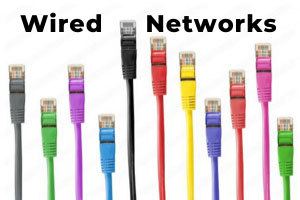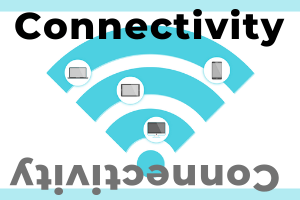You’re running your business in two parallel universes. In one, everything is wireless, free-flowing, connected through Wi-Fi. In the other, Ethernet cables connect every device, creating a network grounded in physical connections. In these two universes, your brain’s electrical vibes somehow influence which technology rules.
Let’s take a look at each of these worlds and see how they’d shape the way you operate, communicate, and get things done.

Wi-Fi Universe – The Wireless World of Flexibility and Accessibility
In the Wi-Fi universe, everything revolves around wireless connections. Here, flexibility is key. Devices are free to roam, not tethered by cables, allowing your team to work from anywhere within reach of the signal. The wireless vibe brings a sense of accessibility, with phones, tablets, and laptops connecting seamlessly. This makes the whole environment feel mobile, collaborative, and easy to access without worrying about plugging in.
For businesses, this wireless environment means fewer limits on where and how people work. People bring their laptops to meetings, shift locations throughout the day, and collaborate in different spaces without the hassle of cables. It’s almost like everything is in constant flow, where connectivity becomes part of the environment instead of something that needs set-up or maintenance.
- Easy movement and setup with no wires holding devices down.
- Collaboration becomes natural, with people able to shift around and meet spontaneously.
- Every device stays connected wherever it goes, reducing downtime and physical restrictions.
The Wi-Fi Drawbacks – Stability and Security Trade-offs
However, this Wi-Fi world isn’t perfect. In a space where everything depends on wireless signals, stability can be hit or miss. Wi-Fi can be affected by walls, interference from other devices, or even just the number of people connected. This sometimes means slower speeds or even interruptions at the worst possible moments. For businesses that need stable, high-speed connectivity at all times, this universe feels a little unpredictable.
Security is another factor. In a world where everything’s connected wirelessly, securing each connection becomes a constant concern. Hackers find it easier to target Wi-Fi than wired connections, meaning every device is at risk unless strict security protocols are in place. In a Wi-Fi-based universe, businesses need to constantly keep an eye on potential vulnerabilities.
- Connection speeds can fluctuate depending on how many people are using the network or where they are.
- Physical barriers like walls and furniture impact the Wi-Fi range and strength, especially in larger spaces.
- Every device and connection requires close security monitoring, as wireless signals are more open to outside threats.

Ethernet Universe – The Grounded World of Stability and Control
In the Ethernet universe, things look and feel very different. Here, every device is connected through cables, creating a network that’s strong, stable, and entirely grounded. This environment relies on physical infrastructure, with each connection anchored by a cable, making it almost immune to the interference issues that come with wireless connections. For businesses, this world provides a sense of control; you know exactly where every connection goes and how it functions.
Ethernet’s reliability is its standout quality. In this world, you won’t worry about dropped connections during an important video call or a critical data transfer. Everything is dependable, steady, and high-speed, making it perfect for tasks that demand bandwidth and security. For businesses that handle sensitive data or need uninterrupted service, the Ethernet universe is like having a secure foundation that never wavers.
- High-speed connections across the network, perfect for transferring large files or streaming.
- Reliable, consistent performance without interruptions, even during peak hours.
- Clear pathways for data with a secure, closed network, offering peace of mind for handling sensitive information.
The Ethernet Drawbacks – Flexibility and Space Constraints
But living in the Ethernet universe isn’t without its quirks. With every device physically connected, moving things around gets tricky. Setting up workspaces, arranging meeting areas, or simply reconfiguring an office can feel limiting. Every time you want to change things up, those cables need re-arranging, which takes time and can limit flexibility. For creative businesses or those that need adaptable spaces, this world can feel restrictive.
Ethernet also limits device mobility. With cables locking everything in place, quick laptop meetings or working from a couch isn’t quite as practical. This environment suits businesses where everyone has a set workspace, but for teams that thrive on mobility or spontaneous collaboration, the Ethernet setup feels a bit like being stuck in place.
- Limited mobility as each device needs to stay connected to a fixed port or connection point.
- Workspace reconfiguration requires time and planning, as each change means dealing with cables.
- Ethernet connections can look messy, with cables running across floors or desks, needing constant organizing.

Business Communication in the Wi-Fi Universe – Staying Connected, Anywhere
In a Wi-Fi universe, business communication flows with ease. Meetings happen wherever there’s a signal—around a conference table, in the breakroom, or even outside. Employees stay connected on their devices from almost any spot, creating a more open, accessible communication style. Messages, video calls, and updates happen smoothly without the need to plug in, making communication feel fluid and continuous.
This wireless approach benefits businesses that value quick, real-time interactions. People connect on the go, without worrying about finding a cable or port. Updates happen in real-time, and teams can reach each other in seconds, no matter where they’re working from. The Wi-Fi world’s setup is ideal for teams that thrive on constant communication and instant connectivity.
- Video calls and team meetings can happen spontaneously, with no need to find a wired connection.
- Employees stay accessible on all devices, with real-time communication supported across the board.
- Fast access to cloud-based systems and apps, making it easy to work remotely or move between devices.
Business Communication in the Ethernet Universe – Stable, Focused, and Purposeful
The Ethernet universe, on the other hand, is all about focus. Communication here is grounded, almost like it’s scheduled rather than spontaneous. Meetings happen at desks or designated workspaces, with every device connected and ready. While you won’t get the same flexibility as Wi-Fi, Ethernet communication is stable and clear, ideal for video calls or presentations without a hiccup.
This approach works well for businesses where focus and depth are more valuable than instant responses. Since devices stay fixed, communication feels structured, without the interruptions that sometimes happen in a Wi-Fi setup. Ethernet’s stable connections give you the freedom to focus on discussions, presentations, or meetings, knowing your connection won’t drop or lag.
- Communication happens in dedicated spaces, where devices are set up for optimal performance.
- Stability in video calls, file sharing, or presentations, ensuring smooth, uninterrupted sessions.
- A focused, organized approach to meetings, with minimal background noise or distractions.
Security in the Wi-Fi Universe – Fast, But Always Under Watch
In the Wi-Fi universe, every connection floats in the air, open to anyone with the right tools. For businesses, this means constantly keeping security measures up-to-date. You’re always working to keep each device secure, monitoring connections, and keeping outsiders from slipping into your network. Security protocols need to be tight and proactive, especially when sensitive information is involved.
This universe makes sense for businesses that prioritize accessibility but are willing to put in extra work for security. Devices need regular updates, and your team has to be aware of security practices to avoid risks. While Wi-Fi offers freedom, it’s a constant task to ensure every connection is safe.
- Consistent security monitoring to keep out unauthorized connections.
- Regular updates and security protocols for every device connected to the network.
- Training employees on Wi-Fi security practices to minimize risks of data breaches.

Security in the Ethernet Universe – Closed, Secure, and Hard to Crack
The Ethernet universe is all about keeping things under wraps. With every device connected by cable, there’s a sense of physical security. No outsider can easily tap into your network without accessing the actual cables. This closed system makes Ethernet ideal for businesses handling sensitive data or operating in high-security industries, where keeping everything secure is non-negotiable.
For you, Ethernet offers a sense of safety that’s hard to achieve with Wi-Fi. The physical nature of the network keeps data contained, making security less of a constant concern. Once set up, you’re free to work with the confidence that your network is secure, stable, and well-protected against outside interference.
- Reduced risk of unauthorized access, thanks to the closed, wired network.
- Less frequent security updates needed, as the physical setup offers a layer of protection.
- Confidence in data security, especially for sensitive or confidential information.
The Wi-Fi Universe vs. Ethernet Universe – Which Fits Your Style?
Each universe brings its own strengths and quirks. The Wi-Fi universe offers freedom, mobility, and ease, letting you and your team stay connected without boundaries. It’s ideal for businesses that value flexibility, adaptability, and an open work environment. But it’s also a place where you’re always keeping an eye on connectivity, managing interference, and making sure every device stays secure.
The Ethernet universe is solid, stable, and grounded, giving you peace of mind with its secure and reliable connections. This world fits businesses that value control, consistency, and security over flexibility. It’s perfect for those who need steady, uninterrupted connections, even if it means sacrificing some mobility.
In the end, the choice between Wi-Fi and Ethernet depends on what your business values most. Each option creates its own version of connectivity, shaping how work gets done, how people communicate, and how secure you feel. Whatever your vibe—whether it’s the fast-paced flow of Wi-Fi or the grounded stability of Ethernet—each has its own way of making things happen.

